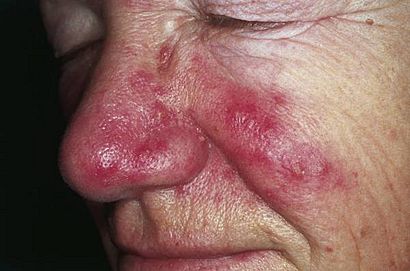Rosacea facts for kids
Quick facts for kids Rosacea |
|
|---|---|
| Synonyms | Acne rosacea |
 |
|
| Rosacea over the cheeks and nose | |
| Symptoms | Facial redness, pimples, swelling, and small and superficial dilated blood vessels |
| Complications | Rhinophyma |
| Usual onset | 30–50 years old |
| Duration | Long term |
| Types | Erythematotelengiectatic, papulopustular, phymatous, ocular |
| Causes | Unknown |
| Risk factors | Family history |
| Diagnostic method | Based on symptoms |
| Similar conditions | Acne, perioral dermatitis, seborrhoeic dermatitis, dermatomyositis, lupus |
| Medication | Antibiotics either by mouth or applied to the skin |
| Frequency | ~5% |
Rosacea is a common skin condition that mainly affects your face. It causes redness and sometimes small, red bumps that look a bit like pimples. It can happen to people of any age, but it often starts in adults between 30 and 50 years old.
If rosacea is not treated, it can sometimes get worse over time. There are four main types of rosacea. Three of these types affect the skin on your face, and the fourth type affects your eyes.
Contents
Who Gets Rosacea?
Rosacea affects many people around the world. It is most common in people with lighter skin, especially those of European background. However, people of other races can also get it.
Both males and females can have rosacea. Females are about three times more likely to get rosacea than males.
What Makes Rosacea Worse?
Many things can make rosacea symptoms appear or get worse. These are called "triggers." Knowing your triggers can help you manage the condition.
Common triggers include:
- Being out in very hot or very cold weather
- Spending too much time in the sun
- Getting a bad sunburn
- Feeling stressed or worried
- Eating spicy foods
- Drinking certain hot beverages
Many people with rosacea have only mild redness. They might not even know they have it and may never see a doctor for treatment.
Symptoms of Rosacea
The main symptom of rosacea is redness on the face, especially on the cheeks, nose, forehead, and chin. This redness can come and go, or it can be constant.
Other symptoms can include:
- Bumps and pimples: Small, red bumps or pimples that look like acne.
- Swelling: The skin might look a bit swollen.
- Visible blood vessels: Tiny blood vessels on the face can become visible, especially on the nose and cheeks. These are called "spider veins" or telangiectasias.
- Eye problems: Some people get a type of rosacea that affects their eyes. Their eyes might feel dry, irritated, or look red. This is called ocular rosacea.
How Doctors Diagnose Rosacea
Doctors usually diagnose rosacea by looking at your skin and asking about your symptoms. There isn't a specific test for rosacea. The doctor will check for the typical redness, bumps, and visible blood vessels. They might also ask about your triggers and family history.
It's important for a doctor to tell the difference between rosacea and other skin conditions that look similar, like acne or eczema.
Treating Rosacea
While there is no cure for rosacea, there are ways to manage the symptoms and keep them under control. Treatment often involves a mix of medicines and lifestyle changes.
- Medicines: Doctors might prescribe creams or gels to put on your skin. These can help reduce redness and bumps. Sometimes, they might prescribe antibiotic pills, which help reduce inflammation.
- Avoiding triggers: Learning what makes your rosacea worse and trying to avoid those things is very important. This could mean using sunscreen, staying cool, or avoiding certain foods.
- Skin care: Using gentle skin care products and avoiding harsh scrubs or cleansers can also help.
With proper care, people with rosacea can usually keep their symptoms under control and live a normal life.
Images for kids
See also
 In Spanish: Rosácea (enfermedad) para niños
In Spanish: Rosácea (enfermedad) para niños



